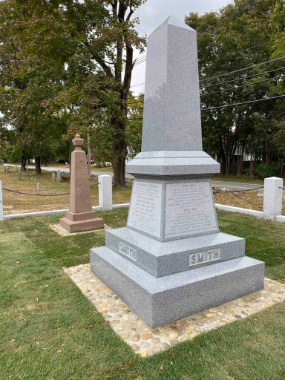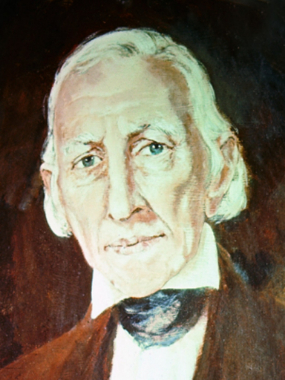| Temple Square is always beautiful in the springtime. Gardeners work to prepare the ground for General Conference. © 2012 Intellectual Reserve, Inc. All rights reserved. | 1 / 2 |
This story appears here courtesy of TheChurchNews.com. It is not for use by other media.
By Sydney Walker, Church News
About 20 miles northeast of Boston’s frenetic pace sits a quiet, well-kept New England village adorned with colonial architecture and rolling hills. Today, the quaint town of Topsfield, Massachusetts, is home to some 6,500 residents.
Almost four centuries ago, Robert Smith — the Prophet Joseph Smith’s third great-grandfather — settled on a farm in Topsfield after emigrating from England. The next four generations of Smiths would live, serve and worship in Topsfield. The Prophet’s father, Joseph Smith Sr., would be born here.
“The world needs to understand that that little community just outside of Boston,” said President M. Russell Ballard, “was really the gathering place of preparing the Prophet Joseph Smith.”
In a recent Church News interview, the Acting President of the Quorum of the Twelve Apostles and descendant of Hyrum Smith, spoke of the history and significance of Topsfield and a monument that was recently erected to honor Joseph Smith’s forefathers.
President Brigham Young once said, “The Lord had his eyes upon [Joseph Smith], and upon his father, and upon his father’s father, and upon their progenitors clear back to … Adam. He has watched that family and that blood as it has circulated from its fountain to the birth of that man. He was foreordained in eternity to preside over this last dispensation.”
Referencing this statement, President Ballard said, “When you see the kind of faith that was manifested early on, in preparation for Joseph to be Joseph, we have to realize that that family was well in the eye of the Lord. … “I stand in awe of the absolute, unwavering faith of that branch of the Smith family. They were believers. They knew the Lord.”
Joseph Smith’s Ancestors
On a sunny mid-September day earlier this fall, an obelisk honoring the Smith family was placed in Topsfield’s Pine Grove Cemetery by the Ensign Peak Foundation (formerly known as the Mormon Historic Sites Foundation) in collaboration with town officials. It will be dedicated in coming months when COVID-19 restrictions ease.
Contracted and funded through generous donations of Latter-day Saints, the monument is inscribed with brief information about each of the five generations of Smiths who came before the Prophet and their contributions. The 9-foot-6 monument is 5 feet wide at its base and weighs 13,868 pounds.
The new monument sits near another Smith marker, placed in the cemetery in 1873 under the direction of President George A. Smith, a counselor to President Brigham Young and first cousin to Joseph Smith Jr. Some of the Smith family are buried in the cemetery, but the locations of their graves are unknown.
“What we hope is that this is a place where their stories can be told,” said Kim Wilson, chairman of the Ensign Peak Foundation, “and that this is also a place that will promote the building of faith and testimony by hearing the stories of courage and faith of these early noble ancestors of the Prophet Joseph.”
The inscription on the frontside of the new monument reads:
“The Smiths of Topsfield: Five generations of a remarkable American family resided in Topsfield beginning with Robert Smith who came to Massachusetts in 1638.
- Robert Smith (1626–1693)
- Samuel Smith I (1666–1748)
- Samuel Smith II (1714–1785)
- Asael Smith (1744–1830)
- Joseph Smith Sr. (1771–1840)

Topsfield
A monument honoring five generations of Joseph Smith’s ancestors is placed in the Pine Grove Cemetery in Topsfield, Massachusetts, in September 2020. 2020 by Intellectual Reserve, Inc. All rights reserved.“Joseph Smith Sr. is the father of Joseph Smith Jr., ‘The American Prophet,’ founder and president of The Church of Jesus Christ of Latter-day Saints.”
Born in Lincolnshire, England, 12-year-old Robert Smith came to Boston as an indentured servant. He worked as a tailor and eventually purchased a large farm in Topsfield in 1661, known as the Smith homestead. He married Mary French, and they had 10 children.
Samuel Smith I was the third of Robert’s sons. He was a carpenter by trade and held offices of public trust in the community. He and his wife, Rebecca Curtis, became the executors of his father’s estate after his older brothers deferred those responsibilities. They had nine children.
Samuel and Rebecca’s firstborn, Samuel Smith II, was an advocate of the Revolution and active in community and civic affairs. He served as a selectman, town clerk, chairman of the Topsfield Tea Committee, member of the state legislature, captain in the local militia and delegate for the Provincial Congress. Samuel II and his wife, Priscilla Gould, had five children.
Samuel II’s passing was noted with the following in the Salem Gazette on November 22, 1785: “He was a sincere friend to the liberties of his country, and a strenuous advocate for the doctrine of Christianity” (as quoted in Joseph Fielding McConkie, “The Early Smiths of Topsfield”).
Asael Smith was the youngest of Samuel II and Priscilla’s five children. He was a landowner, cooper and Revolutionary War soldier and elected to many local offices. He married Mary Duty, and they had 11 children. The first three children, including Joseph Smith Sr., were born in Topsfield. A year after Joseph Sr. was born, the family moved to Windham, New Hampshire, and purchased property in nearby Derryfield in 1778. About eight years later, Asael moved his family back to Topsfield to work the land and pay off his deceased father’s debts. Asael sold the Smith homestead in 1791 and moved his family to Tunbridge, Vermont.
A deeply religious man, Asael prophesied that “something would come forth among his posterity that would revolutionize the world.” Upon hearing of his grandson Joseph Smith’s visions, Asael stated “that he always knew that God was going to raise up some branch of his family to be a great benefit to mankind” (Richard Lloyd Anderson, “Joseph Smith’s New England Heritage”).

Topsfield
A portrait of Joseph Smith Sr.© 2020 by Intellectual Reserve, Inc. All rights reserved.Joseph Smith Sr., the third of Asael and Mary’s children, was a cooper, farmer, teacher and merchant. He met and married Lucy Mack in Tunbridge, Vermont, and they had ten children — the fourth being Joseph Smith Jr., who was born in Sharon in 1805. Failed harvests and economic hardship moved the family between New Hampshire and Vermont. In 1816, they moved to Palmyra, New York, and settled on a farm in nearby Manchester about four years later. This is the area where Joseph Jr. experienced his earliest visions, published the Book of Mormon and organized the Church.
One of the Eight Witnesses to the Book of Mormon, Joseph Smith Sr. was baptized the day the Church was organized in 1830, and he served as the first patriarch of the Church.
Other Smith Markers in Topsfield
The two Smith monuments in the Pine Grove Cemetery aren’t the only markers in Topsfield honoring that family line.
Several years ago, Topsfield resident Norman Isler was acting as a docent at a local historic site when a bus of some 50 Latter-day Saints pulled up, asking where they could find Joseph Smith Sr.’s birthplace — the Smith homestead.
Isler provided the address where a newer home was built on the former site: 22 Boardman Lane. The original Smith family home was razed in the 1870s, but the well that provided water to the Smith families still stands.
A little while later, the group returned, wondering why there wasn’t a marker there. “I said, ‘Well gee, we can put up a marker if you could tell me who to talk to in Salt Lake,’” recalled Isler with a chuckle. He now serves as president of the Topsfield Historical Society.
Isler’s inquiry led to a partnership between the Topsfield Historical Society and the Ensign Peak Foundation to place two historical markers in October 2005 honoring the Smiths’ legacy in Topsfield.
Then-Elder Ballard dedicated the marker on the site of the former Smith homestead — once occupied by Samuel I, Samuel II, Asael and Joseph Smith Sr. — where a young family now resides. The family was enthusiastic about the marker, which sits at the entrance of the driveway into their home and property.

Topsfield
Topsfield Congregational Church marker dedication, Topsfield, Massachusetts, October 16, 2005. Elder M. Russell Ballard of the Quorum of the Twelve Apostles and a Smith descendant participated in the dedication activities. Photo by Johnathan Wisco, courtesy of Church News. All rights reserved.The marker’s inscription reads, “This monument is erected in honor of the Smith family of Topsfield whose lives and character exemplified the cultural, political and religious values of the New England region and of a new and emerging nation.”
That same day in 2005, the bishop of the local Georgetown Ward dedicated a marker on the grounds of the Topsfield Congregational Church, where all five generations of Smiths worshipped.
‘Believing Blood’
Elder Randall K. Bennett, a General Authority Seventy serving as president of the North America Northeast Area, said the story of the early Smiths is “much more than history.” Topsfield is an “integral piece of that divine puzzle,” helping to lead the Prophet Joseph Smith to the Sacred Grove.
Referencing President Russell M. Nelson’s invitation to hear the voice of the Lord, “Members of the Smith family down through the generations are great examples to us of following promptings and impressions from the Holy Ghost, as they moved to the various places they moved (Massachusetts, New Hampshire, Vermont, New York), with Joseph Smith Sr. following his feelings to take his family to New York, near Palmyra, on land adjacent to the Sacred Grove and a short distance from the Hill Cumorah,” he said.
“The promptings may not have always made logical sense, but they followed them, which placed young Joseph Smith at age 14 where he needed to be to usher in the Restoration in this great and last dispensation before the Second Coming of Jesus Christ.”
In light of this year’s 200th anniversary of the First Vision and 400th anniversary of the Mayflower arriving in present-day Massachusetts, “This story of the Smiths is a continuing story of religious freedom,” added Elder Richard Hutchins, an Area Seventy in southeastern Connecticut who has helped coordinate efforts for the new monument.
As visitors walk through Topsfield and see the new monument and other Smith markers, “I think they’ll feel it’s sacred ground, that special things happened there, that people were raised up to accomplish unique purposes and that it’s a sacred place where the Lord helped to facilitate things to come,” Elder Hutchins said.
To President Ballard, one of the great tributes to the faith of Joseph Smith Sr. and Lucy Mack Smith was how they believed young Joseph when he told them of his visions. His mother believed him when Joseph told her of his vision of God the Father and Jesus Christ. His father believed him when he told him of his experience with the angel Moroni.
“That’s the kind of blood that was in the Smith forefathers that coursed in Joseph and Hyrum’s veins,” President Ballard said. “They were believers. They believed in revelation. They believed that the Lord could do whatever He wanted to do. …
“I think that believing blood comes from Topsfield, back into England.”
Copyright 2020 Deseret News Publishing Company